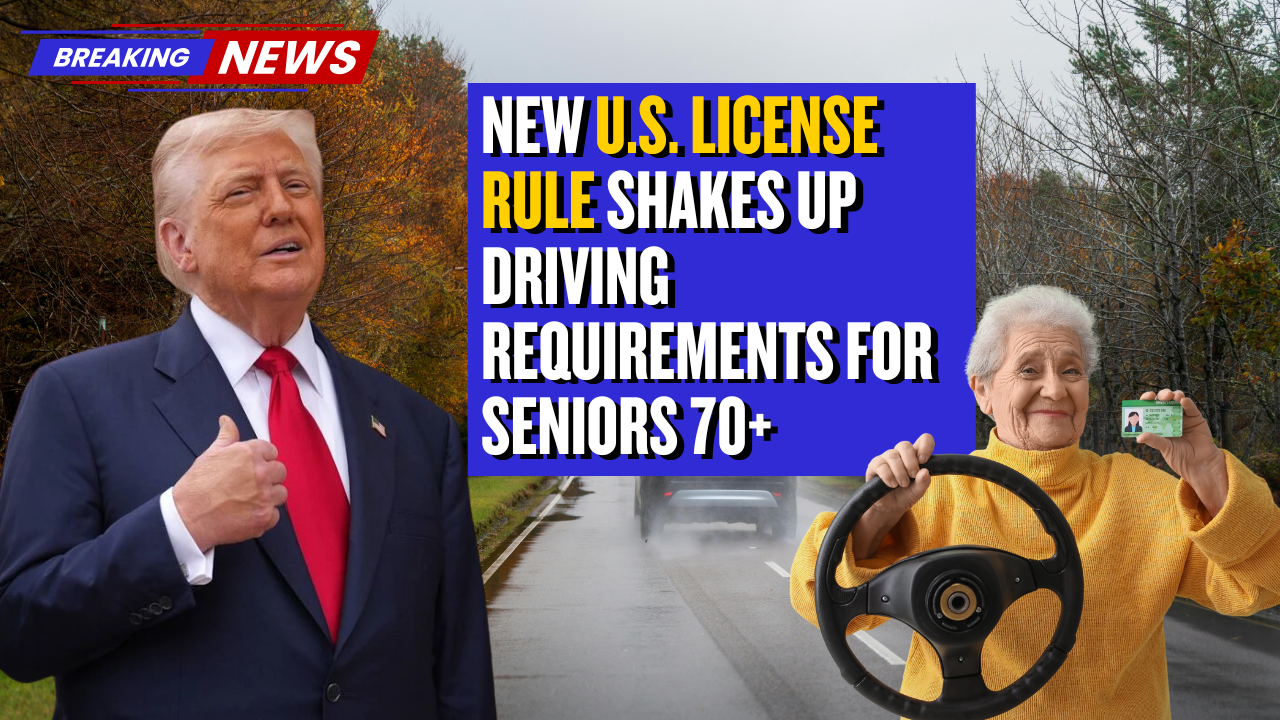Millions of older Americans are adjusting to a sweeping set of changes introduced under the New U.S. Driving License Rule for Seniors, which officially took effect in October 2025. The update brings major modifications to how drivers aged 70 and above renew their licenses, complete testing, and meet medical requirements.
Developed jointly by the U.S. Department of Transportation (DOT) and state Departments of Motor Vehicles (DMVs), the policy aims to strengthen road safety while ensuring older drivers can maintain their independence. With more adults continuing to drive deep into their seventies and eighties, federal officials say the updated rules are designed to reflect public safety priorities and an aging population.
The new standards introduce shorter renewal periods, mandatory medical evaluations, and refresher testing for high-risk drivers — marking the biggest national update to senior driving policy in decades.
Why the Senior Driving Rules Were Updated
Seniors are one of the fastest-growing driver groups in the country. National data shows more than 45 million U.S. drivers are aged 65+, and nearly 13 million are 70 or older. While most remain safe behind the wheel, natural age-related changes — slower reflexes, diminished vision, and reduced mobility — can affect driving performance.
Federal safety agencies have long pushed for more uniform requirements. As part of the DOT’s larger goal to reduce nationwide road fatalities by 20% by 2030, the October 2025 update introduces stricter verification and safety measures, especially in heavily populated states such as California, Florida, and Texas.
Learn more about federal transportation guidelines here:
U.S. Department of Transportation
Key Changes Under the New Senior Driving License Rule (October 2025)
| Category | Previous Rule | New Rule (Oct 2025) | Purpose |
|---|---|---|---|
| Renewal Cycle | Every 5–8 years | Every 3 years (70+) | Ensure frequent medical updates |
| Vision Screening | Optional in many states | Mandatory in-person | Identify declining eyesight |
| Cognitive/Medical Test | Rare | Required (75+) | Detect cognitive or physical impairment |
| In-Person Renewal | Optional | Required from age 70 | Prevent fraud and verify fitness |
| Online Renewal | Allowed widely | Limited to seniors who passed vision/health tests | Maintain convenience with safety |
| Refresher Road Test | Optional | Required after accidents/violations | Assess real-world skills |
How the New Renewal Process Works for Seniors
Starting October 2025, every senior aged 70+ must complete an in-person renewal at their state DMV or an approved testing center. The new process includes:
- Appointment scheduling online or by phone (limited senior walk-ins)
- Identity and residency documentation
- Mandatory vision test
- Medical or cognitive health declaration
- Possible knowledge test or refresher course depending on state policy
Once approved, seniors receive a 3-year license, along with automated reminders tied to age and medical review deadlines.
For personalized state requirements, seniors can refer to the federal directory:
FNS/USDA State Benefit & Eligibility Tools (contains links to all state portals)
Medical Fitness Requirements (Age 75+)
Beginning October 2025, adults 75 and older must provide a medical clearance certificate from a licensed physician. Evaluations typically include:
- Vision acuity and peripheral vision
- Hearing capability
- Cognitive/memory function
- Reflex and decision response
- Neurological or cardiovascular stability
- Impact of medications on driving
Depending on results, the DMV may issue conditional licenses, such as:
- Daylight driving only
- Local-area driving restrictions
- No highway driving
Mandatory Vision Testing for All Senior Drivers
The new rule requires drivers aged 70+ to meet a minimum vision standard of 20/40 in at least one eye. Those who fail must visit an optometrist and reapply after correcting the issue. This change directly targets the estimated 8% of annual accidents linked to impaired vision.
How Different States Are Adapting the Rule
While federal guidelines provide the baseline, states retain flexibility:
| State | License Validity (70+) | Vision Requirement | Additional Rule |
|---|---|---|---|
| California | 3 years | In-person | Cognitive exam at 75+ |
| Florida | Reduced to 6 years | In-person every renewal | Physician clearance at 80+ |
| Texas | 5 years | DMV vision test | Medical review after 79 |
| New York | 5 years | Proof of eye exam | Road test if medically required |
| Illinois | 2 years | On-site test | Annual review after 81 |
Refresher Courses for Senior Drivers
The DOT is partnering with insurers to expand senior defensive driving courses. These one-day programs cover:
- Updated traffic laws
- Modern vehicle safety features
- Defensive driving techniques
- Technology use (lane assist, blind-spot alerts, etc.)
Completion may reduce insurance premiums or waive written tests in some states.
Expected Impact of the New Regulations
Federal officials expect improvements in:
- Senior-related crash reduction
- More accurate fitness evaluations
- Greater peace of mind for families
- Reduced identity fraud through stricter in-person checks
Although some seniors have expressed concern about inconvenience, officials emphasize the rules aim to support safe and independent driving, not restrict it.
Preparing for Renewal (70+ Drivers)
Experts recommend seniors prepare 90 days in advance:
- Schedule a vision exam
- Review state DMV requirements
- Collect ID and proof of residence
- Take a defensive driving course
- Create/Update your DMV online account
Future of Senior Driving Policy in the U.S.
Looking beyond 2025, policymakers are considering:
- AI-driven reaction-time testing
- Virtual driving simulation assessments
- Increased use of in-car safety tech
- Integration of semi-autonomous features for aging drivers
The long-term goal is balancing technological safety with driver independence.
Conclusion
The New U.S. Driving License Rule for Seniors represents a major shift in how America approaches road safety for an aging population. With shorter renewal cycles, mandatory health checks, and stricter evaluations, the October 2025 rules prioritize both safety and independence. For the millions of older adults who continue to drive daily, understanding these changes is essential to staying compliant — and staying safe.



